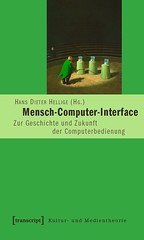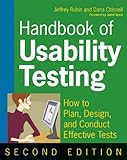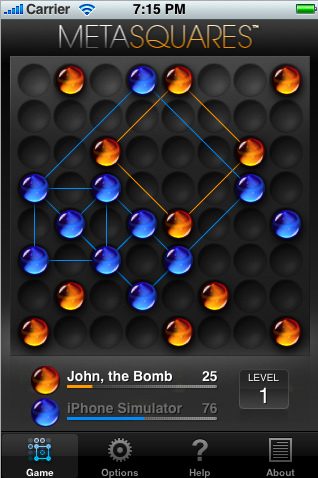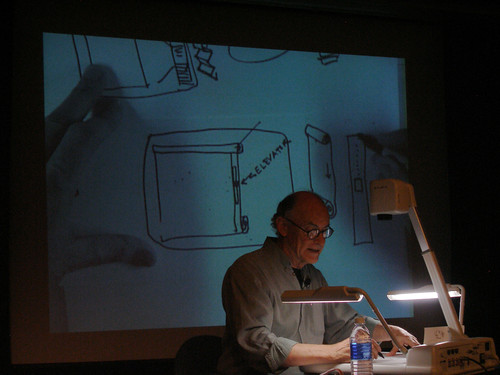MetaSquares, the smart and addictive game by Scott Kim is back — for iPhone, for MacOS X (soon), and a tryout verison for the web.
Author: mprove
Bill Verplank sketches metaphors
_That was quite a remarkable evening, Bill Verplank presenting at BayCHI on Sketching Metaphors. First of all his presentation style. He had an overhead camera connected to the projector in a way that the audience could follow all his actions on the desktop. This gave him the flexibility to simply point to images in a book, show his note cards, or develop (and explain on the way) something entirely from scratch. For example on the image above Bill describes the origin of the window scrollbar and the dead metaphor of an elevator for the thumb control in the bar to the right [metaphors in italics 😉 ]
In a closing section he provided an enlightening diagram on various computer paradigms.
The computer as a tool you can use, the computer as media for information sharing and communicating with each other, and the computer as an intelligent person to interact with. If you go a step further the tools become vehicles, media becomes fashion (take Apple’s iPod as an fashion statement for example), and person becomes life – and ecosystem of self organizing systems.
Thank you Bill, for this framework of computer paradigms.
From Business to Buttons 2008 – Videos
videos and slides of the conference From Business To Buttons 2008 in Malmö/Sweden are now available. Don’t miss Don Norman’s presentation. But I am sure that there are more talks of interest.
more conference webcasts here…
Bucherscheinung: Mensch-Computer-Interface

Frisch erschienen ist von Hans Dieter Hellige (Hrsg.):
“Mensch-Computer-Interface. Zur Geschichte und Zukunft der Computerbedienung”
Die gegenwärtige Interface-Krise bei digitalen Medien nehmen Informatiker und Informatikhistoriker in diesem Band zum Anlass für eine Langzeitbilanz der Mensch-Computer-Interaktion. Sie legen sowohl Gesamtüberblicke der Entwicklung aus technik- und geistesgeschichtlicher Sicht vor als auch spezielle Studien zur Bedienproblematik einzelner Epochen. Dadurch entsteht ein großer Bogen von den Bedienschnittstellen der frühen Mainframe-Welt über die interaktiven PC-Interfaces bis zu den neuesten Entwicklungen des Wearable Computing und der proaktiven Ambient Intelligence. Die historisch-genetischen Analysen münden in theoretische Betrachtungen und kritische Rückblicke auf die Forschung zu Mensch-Computer-Interfaces sowie Ausblicke auf die Zukunft.
Das Buch hat 400 Seiten und ist in der Reihe Kultur- und Medientheorie des transcript Verlags erschienen.
Inhaltsverzeichnis und mehr…
Frieder Nake über Software-Ergonomie
Software-Ergonomie geht entweder im Design auf oder sie geht unter.
On Being Human in a Digital Age
Reconstruction of Bill Buxton’s closing keynote at CHI 2008:
Meilensteine der IT-Revolution als Poster
Die Financial Times hat ein Poster mit den wichtigsten Eckdaten der IT-Revolution zusammengestellt:
(PDF)
Dazu gab es im März/April auch eine zwölfteilige Serie: Die Geschichte der IT-Revolution.
9:1 ratio of bad ideas to good
I tell my clients that I try to maintain a 9:1 ratio of bad ideas to good. And, no, I can’t tell which are which. If only.
Alan Kay's mustache vs. James Gosling's beard
Here’s a convincing theory on the success or failure of programming languages. Statistical data seems to indicate that there is a correlation between market adoption and the beards of the inventors. See Computer Languages and Facial Hair.
Handbook of Usability Testing, 2nd ed.

From Dana:
Hi!
I’m tingling, I’m so excited. I like to think that this is a special event in the user experience world. But every book author probably thinks that.
Handbook of Usability Testing, Second Edition by Jeff Rubin and Dana Chisnell ships on Monday, April 28.
This is not your mother’s HUT. Well, of course not. The first edition was published in 1994. Technology isn’t special anymore, it’s everywhere. (There were DOS examples, for heaven’s sake!) For HUT 2.0, Jeff and I
- Simplified the organization of the main sections
- Reordered many chapters to more closely reflect the flow of planning and conducting a test
- Updated dozens and dozens of examples, samples, and stories
- Expanded and updated discussions about recruiting participants, whether you need a lab, working with observers, analyzing testing data, and (we think) the best way to make recommendations
- Added a chapter on variations on the basic method
- Populated www.wiley.com/go/usabilitytesting with
- electronic versions of many of the deliverables used as examples used in the book
- updated references
- a (we hope) comprehensive list of other resources such as conferences and seminars, other books, blogs, and podcasts.
The drawings and diagrams are have been freshened and improved. The layout and format promise to be less nerdy and more accessible, too.
Oh, and we benefited from sage reviews from Janice James, founder of the Usability Professionals’ Association as our technical editor (brava!), and a foreword by Jared Spool. […]
Hope your experience with HUT 2.0 is good.
P.S. Here’s the official cite:
Rubin and Chisnell, Handbook of Usability Testing, Second Edition: How to Plan, Design, and Conduct Effective Tests (Wiley, 0470185481, 450 pages, April 28, 2008).
Dana’s blog: usabilitytestinghowto.blogspot.com



